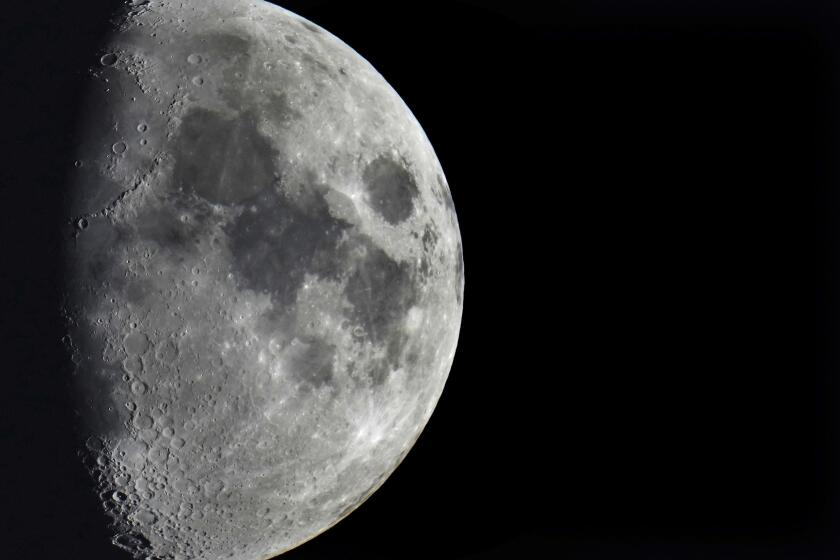
- Share via
Twenty years ago today, I watched TV coverage of a probe descending toward the surface of Titan, a moon of Saturn, while outside my home in Utah snow dusted a rocky mountain outcrop I’d nicknamed Titan — both after the moon and a painting of it.
When the probe — named Huygens, for the 17th century Dutch astronomer Christiaan Huygens who discovered that world — transmitted its first pictures, the painted moonscape clashed with the real one. The artwork, from the 1940s, was shown to be utterly wrong.
Officials said they are making progress in protecting two key science institutions from the Eaton fire.
Chesley Bonestell’s “Saturn as Seen From Titan,” appeared with other planetary scenes in Life magazine, showing what were then considered to be astronomically accurate views of the solar system for the first time. An architectural illustrator and Hollywood matte painter, Bonestell would make a career of space art. His work inspired the very scientists whose research would render many of his paintings factually obsolete.
The Titan illustration is his most famous space scene. In it, Saturn hangs over windswept snow and brown cliffs and outcroppings. The crags frame a glowing Saturn, floating huge, rings nearly edge-on, like a giant’s belt-buckle. Part of the planet is shadowed, blending into the cobalt-turquoise sky. The whole of it is weirdly grand.
What the Huygens probe revealed — a hazy, frigid, dusky-orange world — and what the ethereal painting promised could not be more different.

Released from NASA’s Cassini spacecraft, the Huygens probe descended by parachute for some 2.5 hours before surviving its landing. The European Space Agency craft remains humans’ farthest footfall, some 750 million miles away from Earth.
With a thick nitrogen-methane atmosphere, Titan’s sky is choked with organic compounds, dust and aerosols. This is a world of hydrocarbon seas and vistas of sand and icy rocks. The cold — minus-274 degrees Farenheit — is perhaps the only commonality with Bonestell’s view. (The real Titan may not be as romantic as Bonestell’s, but it is promising: In three years NASA’s Dragonfly mission will send a helicopter to explore Titan’s habitability for life.)
Late Tuesday night Pacific time, on its third try, NASA’s new rocket, and the first Artemis moon mission, is scheduled for liftoff.
The Huygens-Bonestell discrepancy wasn’t the first time that our visions of the solar system were upended by data. Space exploration is, after all, a form of “ground-truthing.”
When spacecraft first reached Mars in the 1960s, the notion of canals built by Martians had to be discarded, though later images would show clear evidence of surface water. The sci-fi jungles of Venus pictured in pulp magazines? Probes showed instead a dense atmosphere and hellish-hot surface. Our own moon’s mountains, long portrayed as sharp and alpine, are instead muscular and rounded.
Yet our obsolete visions retain value.
The troubled Mars mission’s final design won’t be clear until 2026.
In 1944, Bonestell’s illustration offered a compelling answer to the question, “Why explore space?” And even now, knowing it’s far from accurate, the painting’s faint path of light leads us between the cliffs and toward Saturn with this message: If we stay only where we are, then knowledge does too, in or near the frigid lavender of shadows.
Bonestell’s informed-but-imagined solar system evokes the sublime, the sense of being small then empowered in the face of the grand. The scientists who built the Huygens probe that made Titan real were, in their way, doing the same. Both endeavors are examples of the rigors of curiosity born from awe.
This is not, as critics of space exploration suggest, a form of belittling or ignoring our terrestrial challenges. Quite the opposite. The sublime strengthens our bonds with the cosmos and all it signifies: beauty and dread, imagination and fact, the thrill of discovery and fear of the unknown. Painted or transmitted, other worlds can fire the imagination and at the same time underline the value of the one we inhabit. That mountain outcrop I still think of as Titan reminds me of the painting, the probe, space “out there” and the space I occupy right here on Earth.
Christopher Cokinos is the author of “Still as Bright: An Illuminating History of the Moon from Antiquity to Tomorrow.” He lives in northern Utah.
More to Read
A cure for the common opinion
Get thought-provoking perspectives with our weekly newsletter.
You may occasionally receive promotional content from the Los Angeles Times.













